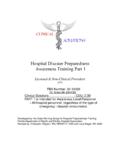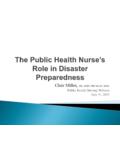Transcription of KECK Chemical Spill Response Guideline
1 1. Chemical Spill Response Guideline 2. Table of Contents 1. Introduction 3. 2. Roles & Responsibilities 3. Chemical Safety Officer 3. Worker 3. Supervisor or Principle Investigator 3. Chemical Spill Team Captain (s) 4. 3. Spill Prevention 4. Storage 4. Transport 5. Decanting 5. Handling & Use 5. Disposal 6. 4. Spill Response Preparation 6. Training 6. Hazard Information 6. Equipment 7. Procedures 7. 5. Spill Response 7. Spill Response Guide No. 1: Flammable Liquids 7. Spill Response Guide No. 2: Combustible Liquids 8. Spill Response Guide No. 3: Acids 9. Spill Response Guide No. 4: Alkali & Bases 11. Spill Response Guide No. 5: Mercury 12. Spill Response Guide No. 6: Oxidizers 13. Spill Response Guide No. 7: Highly Toxic Materials 14. Spill Response Guide No. 8: Low Hazards Materials 16. Spill Response Guide No. 9: Air & Water Reactive Materials 17. Spill Response Guide No. 10: Compressed Gas Leaks 17.
2 6. Reporting Chemical Incidents 18. Appendix A: Chemical Spill Kits 18. Appendix B: Keck Graduate Institute Chemical Spill Response Flowchart 19. 3. 1. Introduction A Chemical Spill is defined as the uncontrolled release of a hazardous Chemical , either as a solid, liquid or a gas. Chemical spills at Keck Graduate Institute may occur in a variety of worksites, from research &. teaching laboratories, to facilities operations. The challenges related to dealing with Chemical spills will vary with the type and volume of Chemical involved. Chemical spills in laboratories generally involve small volumes of a potentially large number of chemicals. Regardless of the type or quantity of hazardous Chemical involved, all worksites must implement measures to reduce the potential for spills and have a plan for responding to Chemical spills. This document describes generic methods for preventing Chemical spills, responding to spills of low or moderate hazard and information on reporting and addressing higher hazard Chemical spills at Keck Graduate Institute.
3 2. Roles and Responsibilities Chemical Safety Officer Implement measures to prevent potential spills of hazardous materials. Develop site specific Spill Response procedures where controlled products are used or stored that present a special risk upon exposure. Appoint Chemical Spill Team members; and a Team Captain Provide support to the Chemical Spill Team. The Worker Under the OH&S Act, the worker has an obligation to protect their own health and safety and that of other workers present while they are working. The worker is also expected to cooperate with their employer for the purpose of protecting their health and safety and that of other workers. Specifically, these responsibilities include: Take all necessary steps to minimize the chance of spills when working with chemicals (see 3. Spill Prevention). Cooperate with their supervisor, the CSO, and the Chemical Spill Team to implement a Chemical Spill program in their area.
4 The Supervisor or Principal Investigator Supervisors and Principal Investigators when involved in the supervision of staff members, students, post doctoral fellows or others are responsible for performing the duties of the employer specified under the Act as designated representatives of the University. Specifically, these include: Ensuring that an adequate number of persons are trained in Chemical Spill Response for their specific area. Provide site-specific training for their area. Ensuring there is sufficient and appropriate Spill Response supplies in their area. Take all necessary steps to minimize the chance of spills when working with chemicals (see 3. Spill Prevention). Cooperate with the CSO and the Chemical Spill Team to implement a Chemical Spill program in their area. 4. The Chemical Spill Team and Team Captain Provide assistance in Response to Chemical spills. The extent to which the Spill team and other personnel respond to Chemical spills will vary with policy.
5 The Spill Team Captain will coordinate Response and summoning of additional Response personnel, and will be available after hours to provide assistance in the event of a Spill . Provide site-specific training to lab members who work with chemicals and will potentially be involved in Chemical Spill / emergency Response situations. Regularly inspect labs to ensure that Spill kits are available and that supplies are relevant to the chemicals being handled in the area for which the Spill kit is designated for use. Maintain records regarding inspections conducted, training conducted and Spill kit maintenance. 3. Spill Prevention The first step in Chemical Spill Response is to prevent the Spill from happening in the first place. The worksite should be examined to identify measures that can be taken to minimize the risk of a Chemical Spill occurring. These measures can be identified during regular worksite safety inspections.
6 Chemical spills occur during five types of activities; storage, transport, transfers, usage and disposal. Storage Ensure shelving units are sturdy, and not overcrowded with containers. Shelves used for Chemical storage should be securely fastened to the wall or floor to provide added stability. Ensure chemicals are stored within easy reach of everyone in the lab, and no higher than eye level. Large bottles and containers should be stored as close to floor level as possible. Do not store Chemical containers directly on the floor where they might be knocked over and broken, unless they are in approved safety cans or still in their original shipping carton and packing. Do not store Chemical containers on top of flammable storage or acid storage cabinets. Minimize the number of chemicals and size of containers stored in the lab. For commonly used chemicals ( acids, solvents), a good rule of thumb is to keep quantities in the lab to either a single bottle or a one-week supply, whichever is less.
7 Ensure that lighting and ventilation is adequate is the storage area. Regularly inspect chemicals in storage to ensure there are no leaking or deteriorating containers. Some items to note: o Keep the outside of containers clean and free of spills and stains. o Check that caps and closures are secure and free of deformation. Use only screw caps on TM. Chemical containers in storage; foil, Parafilm , corks or other plugs are not acceptable. o Ensure that metal containers are free of rust, bulges or signs of pressure buildup. Do not store chemicals in unsuitable containers or containers made of incompatible material (eg: no HF in glass containers). Do not store incompatible chemicals together ( acids with bases). Chemicals must be stored by hazard category and not alphabetically (except within a hazard group). Purchase solvents in containers with a plastic safety coating. 5. Ensure that all gas cylinders are securely fastened and upright.
8 Transport When transporting large, heavy or a multitude of containers use a cart suitable for the load with high edges or Spill trays that will contain any spills or leaks. Two people should be involved when transporting large amounts of chemicals. Carry glass containers in bottle carriers or another leak resistant, unbreakable secondary container. Use a gas cylinder handcart when transporting large gas cylinders. Ensure cylinder is securely strapped to the cart. Comply with the California DOT and Transportation of Dangerous Goods Regulations when transporting hazardous material on public roads. See internet links below for specific regulations. #hm DOT's Office of Hazardous Materials Safety: (800) 467-4922. For assistance classifying shipments Decanting When transferring chemicals between containers, pay careful attention to the size of the receiving container to prevent overfilling it.
9 When transferring liquids from large containers, use pumps, siphoning (not initiated by mouth) or other mechanical means instead of pouring. Use Spill containment trays to catch leaks and spills when transferring liquids. When transferring flammable liquid from drums, ensure that both the drum and receptacle are grounded and bonded together to avoid an explosion initiated by a static electric spark. Handling & Use In laboratories, work in a fume hood whenever possible. When setting up and working with laboratory apparatus: o Inspect laboratory glassware for cracks or defects before using it. o Secure flasks and beakers to prevent them from tipping over. o Do not stage experiments below heavy objects which might fall on them. Ensure the work area is free of unnecessary clutter. o Select equipment that has a reduced potential for breakage ( Pyrex). o Replace mercury with alcohol thermometers or other alternate type of temperature measuring device.
10 When planning experiments, anticipate possible accidents and provide controls to deal with problems that may occur. 6. If you must work alone, ensure the working alone protocol addresses Chemical Spill Response as part of the emergency procedures Check gas cylinder valves and gas tubing for leakage before use. If possible, keep cylinders of highly toxic or corrosive gases in a fume hood or other ventilated enclosure. Ensure you have access and know the location of a suitable Chemical Spill kit before you start working with chemicals. Disposal Do not mix incompatible wastes together to avoid uncontrolled Chemical reactions. Properly identify the contents of all waste containers to avoid inappropriate disposal. Leave at least 20% air space in bottles of liquid waste to allow for vapor expansion and to reduce the potential for spills due to overfilling. When not in use, keep waste containers securely closed or capped.




